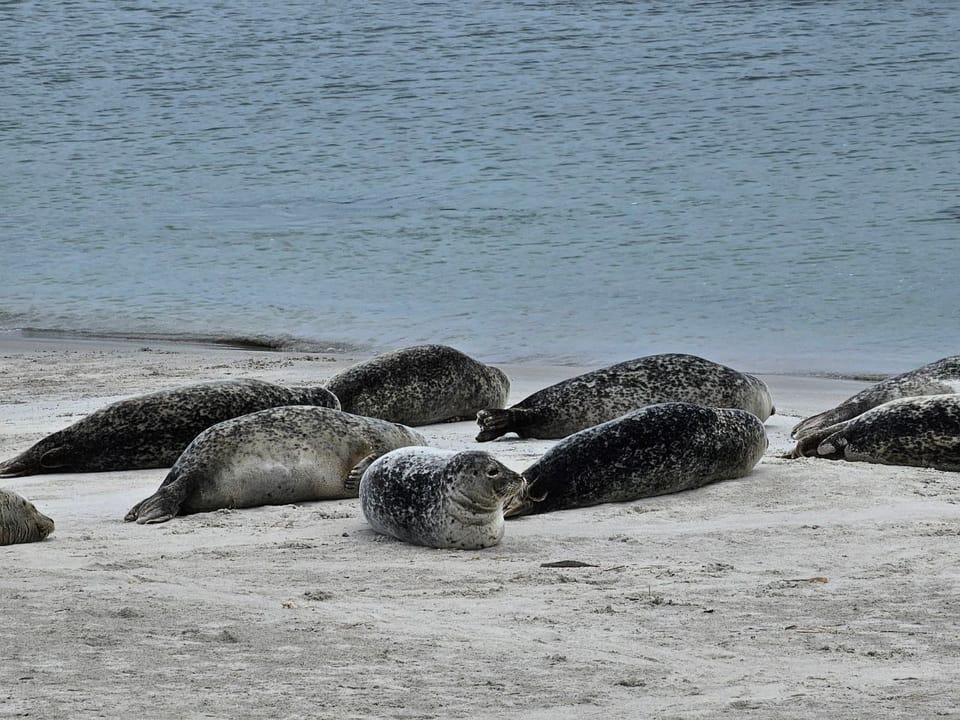...and what if it were wonderful? (Part 3)

Three nights ago, I dreamed a coworker called and cheerfully told me that the president was on the line for me. In his pouty, threatening voice, Donald personally “suggested” that it would be better for me if I didn’t return to the U.S. from Germany. In the background, his staffers murmured about making an “example of the activists.” It took me ten minutes of snuggling with Danny in the early morning light to recover.
The threat lives only in my dreams, at least for now; others aren’t so lucky. Whether you’re personally targeted by the administration or watching from afar like me, many of us are experiencing this time somewhere on a spectrum from numb to abject terror.
So I know that it may seem fantastical, tone deaf, or even offensive to suggest that we could make something wonderful of this moment. But hear me out.
The day after my dream, I was in Helgoland, a less-than-one-square-mile island 40 miles off the coast of Germany in the North Sea. We took the ferry for an overnight to visit the seals—Danny’s favorite animal—that make Helgoland’s dune their rest stop and galumphing grounds.
On that very day 78 years ago, we learned, the British bombed Helgoland with half the firepower of Hiroshima. A bombed-out crater is still plainly visible from the paths of the island’s upper plateau; we walked its rim. Two years after WWII’s end, the British wanted to destroy the miles of bunkers the Nazis had built underground, just to be safe—to ensure Nazi plans for a massive offshore military base could never be realized.
Some Helgolanders resisted the Nazis, and some tried to stop the British bombardment. But one fact stayed with me: After the British all but destroyed their home, Helgolanders—some 2,000 people with shared culture and language, living in exile throughout northern towns on the German mainland—organized for years, using creative nonviolent tactics, until they were permitted to return and rebuild.
Now and historically, the people on the front lines of change are often those who have no choice but to agitate, activate, and organize for their own survival.
In my last post, I posited that organizing is the answer. There are books, essays, articles, speeches, classes, about how to organize; I’m not trying to rewrite them here.
Today, I just want to talk about getting started—for those of us who still have the luxury of choosing whether or not to do so.
Below, a simple how-to. But first, a note: Getting started requires hope. To get started, you have to believe in the chance—even the most miniscule—that your trying could make things better.
So before you read the rest, consider: What if it were wonderful? What if the change I hope for came to pass—what would it look like, feel like, smell like? And what if the process of getting there were wonderful, too? Close your eyes and imagine it being wonderful: the working toward it, and the getting there.
I know! But go on, do it. Just for a moment.
If you need more on hope, start here, or here. The rest of this little piece is about how to get started.
**
As an organizer, I’m frequently asked some version of, “What can I do?”
Here’s one way to figure it out.
It’s designed for someone new to organizing, to get started with an established organization that already has clear goals and strategic grounding you can get behind. There are other approaches; more on that in the future.
I’ve refined this over the years through test runs and with organizer collaborators. (Special shoutout to Julia Gabbert and Matt Garza.)
This is the quick version. I recommend investing 15 minutes, though, in this simple worksheet. It has more depth, explanations of the prompts, and examples.
Ask yourself: If I’m serious about wanting to make a difference in this moment…
Step 1: You.
- How much time do I have, and when?
- What am I good at that I’d like to put to use?
- What issues am I most passionate about?
Step 2: Us.
- What organizations do I already know about that seem cool? Who can I ask for recommendations? (Hint: 👋)
- Search online for local organizations. (Google your city/town + issue you care about.) What comes up? What opportunities do they list?
- Some national organizations have local chapters. Can you find upcoming meetings?
Step 3: Now.
- Take a tangible first step: sign up for an online training, join an in-person event, have a one-on-one coffee with a staff member. Put it on your calendar. Attend!
- Don’t give up on the first try. If it’s an issue or an org you care about, show up three times in three different ways. Give them three chances to woo you and get you involved.
- If, after that, you’re not feeling it, move on. Pick a different organization and try again—but don’t give up on getting involved in something.
That last point is key. I say “don’t give up,” because organizing is rarely wonderful from the beginning. Relationships, and tasting success, are what make it wonderful, and those take time.
People often ask how I stay hopeful, since my job is to be immersed in the world of corporate abuse. And they’re often surprised by my reply: I think I’m more hopeful than most people I know.
I attribute this to being an organizer. Every day, I work with people who are actively engaged in making things better—sometimes under much tougher conditions than I’ve so far faced in the U.S. I get to see victories, big and small, that others never know about. Organizing is a feedback loop—it gives me the hope to keep organizing.
So that’s my last tip: If you feel like your hope is on its very last legs, start organizing anyway. You just might find that it sparks the hope you need right now.
Today, not quite 80 years since the British nearly bombed it into the sea, Helgoland is gorgeous. As Danny and I strolled, the seals stretched their flippers on the sand at the water’s edge, twisting their heads to regard us with big, curious eyes. The yellow-dusted Northern gannets cooed over their nests on the rocky red cliffs. The green sea cabbage that has grown to fill in the bombed-out crater rustled in the gusts off the ocean.
It was more than gorgeous. What was once unthinkable devastation is, today, wonderful. It’s wonderful because a group of Helgolanders held onto hope. They organized. Their home was worth fighting for.
And maybe dream-Donald was right. Maybe it’d be better for me, personally, to stay in Germany. But when my time here is up, I know I’ll come back to the U.S., and not just because my German visa will expire. I’ll come back, and I’ll keep organizing. Because it’s worth fighting to make my home wonderful, too.
You in?
Love,
Ari
What else?
Some national-level opportunities to explore:
- Not to be a broken record, but the Rise for Freedom trainings are a great place to start building organizing skills.
- Indivisible has local groups in all corners of the U.S. organizing at the local level to challenge Trump and Musk.
- Care about the climate? Over 60 years old? Check out Third Act.
- MoveOn.org has always impressed me with their organizing infrastructure, including the opportunities they create for people to plug in from anywhere.
- Corporate Accountability’s nascent, still experimental, People Over Profit Corps is for those who want to stop the corporate coup and build community online.
- A little different: mutual aid is a great way to directly support people in your community facing the impacts of, say, slashed social services. You can find and plug into a local mutual aid group here.
- What have I missed? I’d love to know. Send ideas my way.
P.S. Whether or not this post was useful to you, maybe you know someone who could use a nudge and/or a how-to in this moment. Feel free to share.

Member discussion